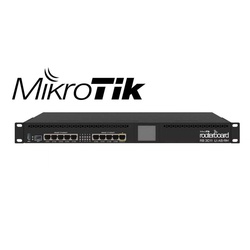
MikroTik RB2011UiAS-RM Routerboard Rackmount 5xLAN 5xGbit LAN 1xSFP
by Mikrotik
The MikroTik RB2011UiAS-RM is a routerboard designed for rackmount installation. It comes with five Ethernet ports (LAN) and five Gigabit Ethernet ports (Gbit LAN), as well as one Small Form-factor Pluggable (SFP) port. The RB2011UiAS-RM is powered by RouterOS, a robust routing operating system that has been continually enhanced over the course of fifteen years.
- Dynamic routing: RouterOS supports various dynamic routing protocols, such as RIP, OSPF, and BGP, allowing the router to exchange routing information with other routers in the network dynamically.
- Hotspot: It includes a built-in hotspot management system, which enables the creation of public access networks with customizable authentication, billing, and captive portal features.
- Firewall: RouterOS has a powerful firewall module that provides advanced security features, including packet filtering, connection tracking, and Network Address Translation (NAT), helping to protect the network from unauthorized access and malicious activities.
- MPLS (Multi-Protocol Label Switching): It supports MPLS, a protocol used for efficient forwarding of network traffic, enabling the creation of virtual private networks (VPNs) and traffic engineering capabilities.
- VPN (Virtual Private Network): RouterOS can establish secure connections over public networks using various VPN protocols like PPTP, L2TP, IPsec, and OpenVPN, allowing remote access to the network or interconnecting different locations securely.
| SKU | 1147 |
|---|
Reviews
This product does not have any reviews yet.
Add your reviewDescription
MikroTik RB2011UiAS-RM Routerboard Rackmount 5xLAN 5xGbit LAN 1xSFP
The MikroTik RB2011UiAS-RM Routerboard is a rackmount router that offers a wide range of features and functionality. It is powered by RouterOS, a comprehensive routing operating system that has been continuously developed and improved over the course of fifteen years.
The RB2011UiAS-RM model comes with 5xLAN ports, allowing you to connect multiple devices through Ethernet cables. Additionally, it offers 5xGigabit LAN ports, which provide higher data transfer speeds compared to standard Ethernet ports. Furthermore, it includes 1xSFP (Small Form-factor Pluggable) port, enabling fiber optic connectivity for long-distance communication.
RouterOS, the operating system running on the RB2011UiAS-RM, supports various advanced networking features. These features include dynamic routing protocols, such as OSPF (Open Shortest Path First) and BGP (Border Gateway Protocol), which facilitate efficient routing within complex networks. It also offers hotspot functionality, allowing you to create and manage Wi-Fi hotspots for guest access or other purposes.
The firewall capabilities of RouterOS enable you to enhance network security by controlling incoming and outgoing traffic based on predefined rules. MPLS (Multiprotocol Label Switching) support allows for the creation of virtual private networks (VPNs) and the efficient forwarding of network traffic.
Furthermore, the RB2011UiAS-RM supports advanced quality of service (QoS) features, enabling you to prioritize certain types of network traffic to ensure optimal performance for critical applications. Load balancing and bonding capabilities allow you to distribute network traffic across multiple connections, increasing overall network capacity and redundancy.
One of the notable aspects of RouterOS is its real-time configuration and monitoring capabilities. You can make configuration changes on the fly, without requiring a system reboot, and monitor network activity and performance in real-time.
In summary, the MikroTik RB2011UiAS-RM Routerboard is a feature-rich rackmount router powered by RouterOS. With its diverse range of capabilities, including dynamic routing, hotspot functionality, firewall, MPLS, VPN support, advanced QoS, load balancing and bonding, and real-time configuration and monitoring, it provides a comprehensive solution for managing and optimizing network connectivity.
Key features supported by RouterOS on the MikroTik RB2011UiAS-RM Routerboard:
-
Dynamic Routing: RouterOS supports various dynamic routing protocols such as OSPF (Open Shortest Path First), BGP (Border Gateway Protocol), RIP (Routing Information Protocol), and more. These protocols enable efficient and automated routing within complex networks.
-
Hotspot: With RouterOS, you can create and manage Wi-Fi hotspots for guest access or other purposes. This feature includes customizable login pages, user authentication, and traffic control.
-
Firewall: RouterOS provides robust firewall capabilities to enhance network security. You can define rules to control incoming and outgoing traffic based on source/destination IP addresses, ports, protocols, and other parameters.
-
MPLS (Multiprotocol Label Switching): RouterOS supports MPLS, which enables the creation of virtual private networks (VPNs) and efficient forwarding of network traffic. MPLS helps optimize network performance and provides better control over data flows.
-
VPN (Virtual Private Network): RouterOS allows you to set up secure VPN connections using various tunneling protocols like PPTP, L2TP, SSTP, IPsec, and OpenVPN. This feature enables secure communication between remote networks or individual devices.
-
Advanced Quality of Service (QoS): RouterOS offers advanced QoS capabilities, allowing you to prioritize certain types of network traffic. You can assign different levels of importance or bandwidth allocations to specific applications, ensuring optimal performance for critical services.
-
Load Balancing and Bonding: RouterOS supports load balancing and bonding techniques, which distribute network traffic across multiple connections. This helps improve network capacity, redundancy, and overall performance.
-
Real-time Configuration and Monitoring: RouterOS allows you to configure and monitor your network in real-time. You can make changes to the configuration without requiring a system reboot, and monitor network activity, performance, and resource usage through intuitive interfaces.

